
Are AI Overviews Worth Pursuing? — Next Level
If there is one thing we can all agree on, it’s that talk about AI Overviews (AIOs), AI Mode, and AI in general seems to be everywhere. Google’s addition of these features has turned marketers and SEOs on their heads, trying to assess how it impacts their business, traffic, and ultimately their strategy.
So, what do we know about AIOs, and how can we adjust our strategies to account for them?
What are AIOs, and where do they show up?
As a refresher, AI Overviews (also known as AIOs) are a recently introduced SERP feature from Google. Essentially, they use generative AI and multiple sources from around the web to create one response that appears at the top of the search results.
According to Google, “AI Overviews help people get to the gist of a complicated topic or question more quickly, and provide a jumping off point to explore links to learn more. They were designed to show up on queries where they can add additional benefits beyond what people might already get on Search.”
Despite Google’s (alleged?) intent for these to be a jumping off point for more in-depth research, marketers have seen a dip in organic traffic as a direct result of implementing this feature. According to one study by Growth Memo, CTR on desktop has dropped as much as two-thirds when an AIO shows up in the results.
Another thing to note about AIOs is the type of results they typically show up for. Based on Google’s own wording, it comes as no surprise that AIOs populate most frequently in searches with informational intent. My fellow Mozzer, Tom Capper, actually released a Whiteboard Friday earlier this year outlining data around the presence of AI Overviews in different types of searches, which I highly recommend checking out.
So, with all this information in mind, should we change our content strategies and how we measure success? And if so, what could that look like?
Should I change my content strategy based on AI Overviews?
When it comes to making strategic decisions about your content strategy, it pays to consider multiple factors and data points before making any drastic changes. And although I hate to be a cliche, the classic answer to whether you should change your strategy based on the presence of AIOs really is: It depends.
The reality is, AI Overviews will impact your traffic. Their implementation has resulted in a significant decline in clicks from SERPs where they are included. Even if you are featured as a source in the AIO itself, users are still less likely to click through to your website. This means we need to reframe how we measure success and consider when (and where) we may be able to accept that loss in traffic.
Here are a few questions to ask yourself when assessing the impact of AIOs on your business and whether or not you should pursue them:
What keywords are driving traffic to my website, and are those visitors converting?
It helps to know where we’re starting before we decide where we’re going and how we’ll get there. So, before making any big changes, assess what keywords are driving traffic to your site and how many of those visits are converting.
In addition to looking at which keywords are driving traffic, take a look at where you’re gaining the most impressions. Are there keywords where you have a lot of impressions but very few clicks? Should they be driving traffic to your site?
Are you losing traffic to AI Overviews?
Adapt your keyword strategy with AIO features in Keyword Explorer
Here’s the thing: Not all keywords are created equal. Now is the time to examine what is working and what isn’t. I have two mini frameworks I can use to analyze my target keyword performance in an AIO world.
Analyze target keywords for AI Overview appearances
The first option is to analyze your target keywords. One benefit of analyzing by keyword is that I’ll be able to see if I have target keywords where my content isn’t being ranked or where there are opportunities to create content to better fulfill my goals.
Here’s how I would approach this method:
- List my target keywords.
- Pull impression and click data from Google Search Console (GSC) and cross-reference that data with my most important keywords.
- Identify the primary search intent for my target keywords with Keyword Explorer.
- Verify if an AI Overview is present in the search results with Keyword Explorer.
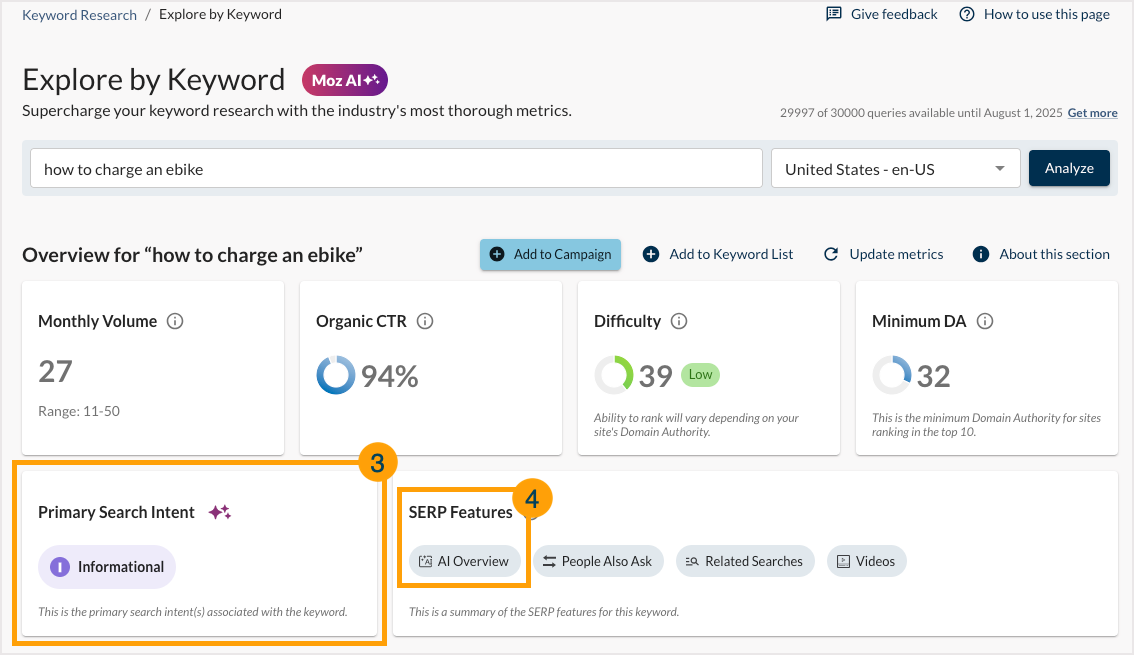
Analyze a list of categorized URLs for AI Overview appearances
Alternatively, I can analyze my data by content. The benefit of assessing by content rather than by keyword is that I will be able to see where my content is currently appearing in the SERPS and whether I have existing content that needs to be updated.
There may be pieces of content that I can update to compete for a spot in the AIO or that need to be moved in a different direction for better results. For example, if I have a piece of content that is meant to be conversion-focused but isn’t getting any clicks, maybe I need to update it to target a different keyword cluster so customers find it at the right time in their journey.
Here is how I would approach this method:
- Gather a list of my URLs — blog posts, FAQ pages, product pages, etc.
- Identify the content's intent — is it conversion-focused, informational, instructional, etc.? I may also opt to identify which stage of the sales funnel it is meant to target.
- Pull impression and click data for these URLs from GSC.
- Use GSC to pull the keywords that are driving those clicks and impressions.
- Use Keyword Explorer to identify which keywords include an AIO in the search results.
See when AI Overviews appear for your keywords
So you can dominate visibility, not just rankings.
So, what do I do with this data? I can now examine which keywords and content are being impacted by the presence of AIOs in the SERP and determine whether I want to target those AIOs or if I need to mix things up.
Who is currently featured in the AI Overviews for my target keywords?
As our next step, I’ll need to understand whether it's feasible (and worth it) to attempt to gain that coveted spot as a cited source in an AI Overview.
First, consider the Difficulty associated with the keyword. If the SERP is highly competitive and the Difficulty score is particularly high, it is likely that it will be much harder to break into the AIO.
Pro tip! You can pull this metric from right within Keyword Explorer in the same view you used to see if an AIO was present.
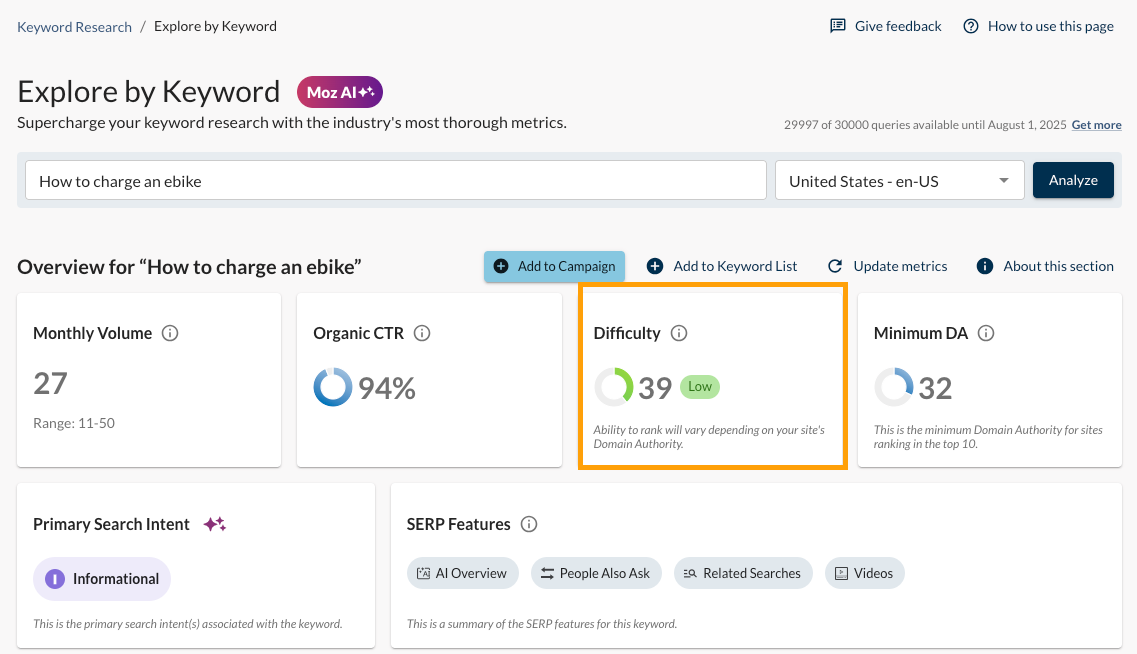
Next, take a look at who is already represented in the AI Overview. What type of content is featured? What types of sites are cited? The size and type of competitors listed in the AIO will give a lot of insight into what Google is looking for when it answers this query. It will also give you an idea of who you have to beat to get featured.
For example, if you see well-known, highly authoritative sites in the AIO, it will be much harder to take over those spots than if a smaller site or less well-known company is featured. Additionally, if you’re seeing sites like Reddit or Quora listed, this could indicate that Google is looking for first-person experiences to provide its answer.
Pro tip! In Keyword Explorer, you can use the SERP Analysis feature to see what is included in the AI Overview and which sites are featured.
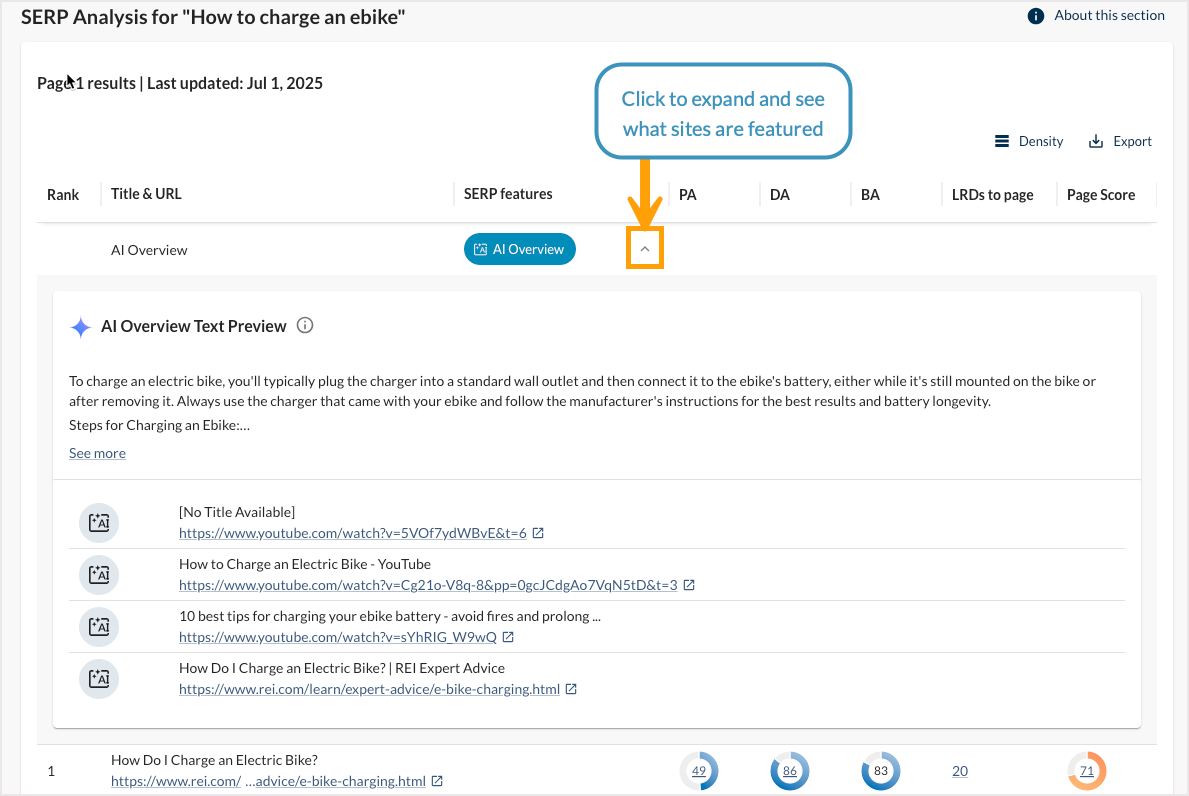
What if I’m already featured in the AI Overview?
As you do your research and gather information about who is currently included in the AI Overview for your target keywords, you may find that you’re already featured in some. Great work!
Now it’s all about holding on tightly to that position. If maintaining your spot is a key part of your strategy, monitor your inclusion and make sure your content stays up to date and relevant so you can hopefully hold on to that spot in the SERP.
What would I gain from being featured in the AI Overview for my target keywords?
Now we know where AIOs are showing up and who is currently included in them. So here’s the big question — is it worth it to go after them? Or should I adjust my strategy to account for them?
I find that this really comes down to what you expect to gain from being featured in an AI Overview. Knowing that clicks from SERPs that feature an AIO are limited, it’s important to have clear goals (other than traffic) from the outset so that stakeholders and clients know what to expect. AI Overviews are a great way to:
- Build brand awareness and authority
- Validate that you're providing content that helps your audience
- Build audience trust
For example, here is a query for “How to add keywords to Moz Pro.” This query is clearly answered in the AI Overview, and it is unlikely that a searcher would need to (or want to) click through to moz.com. This keyword and its associated AIO would instead serve to build brand awareness and trust.
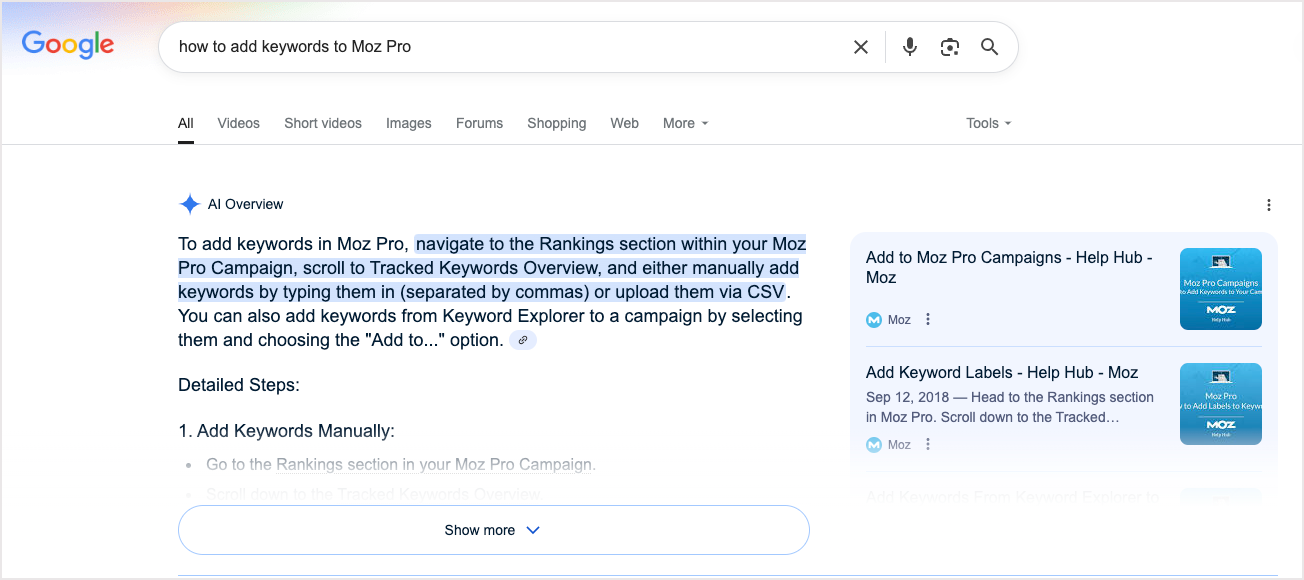
However, if your primary goal is to drive traffic to your website or conversions, being featured in the AI Overview likely won’t yield the results you’re looking for. In this case, it may be worth considering a different strategy for your content than specifically targeting AIOs.
Measure your Brand Authority with trusted metrics from Moz

How can I adjust my content strategy?
Now that we’ve looked at the data, considered our goals, and made some decisions about whether to target AI Overviews, how do we adjust our strategies?
AI Overview content strategy
If you are aiming to gain a spot in the AI Overview, there are a few ways you can optimize your content to increase your chances of being featured.
- Use elements like quotes and statistics that can be pulled out and featured
- Write content that aligns with EEAT to demonstrate authoritativeness and trustworthiness
- Include first-person experiences and language
- Consider the types of content already featured and adapt your content to match (for example, if the AIO is featuring videos, consider creating a video and embedding it in your content and posting it on YouTube)
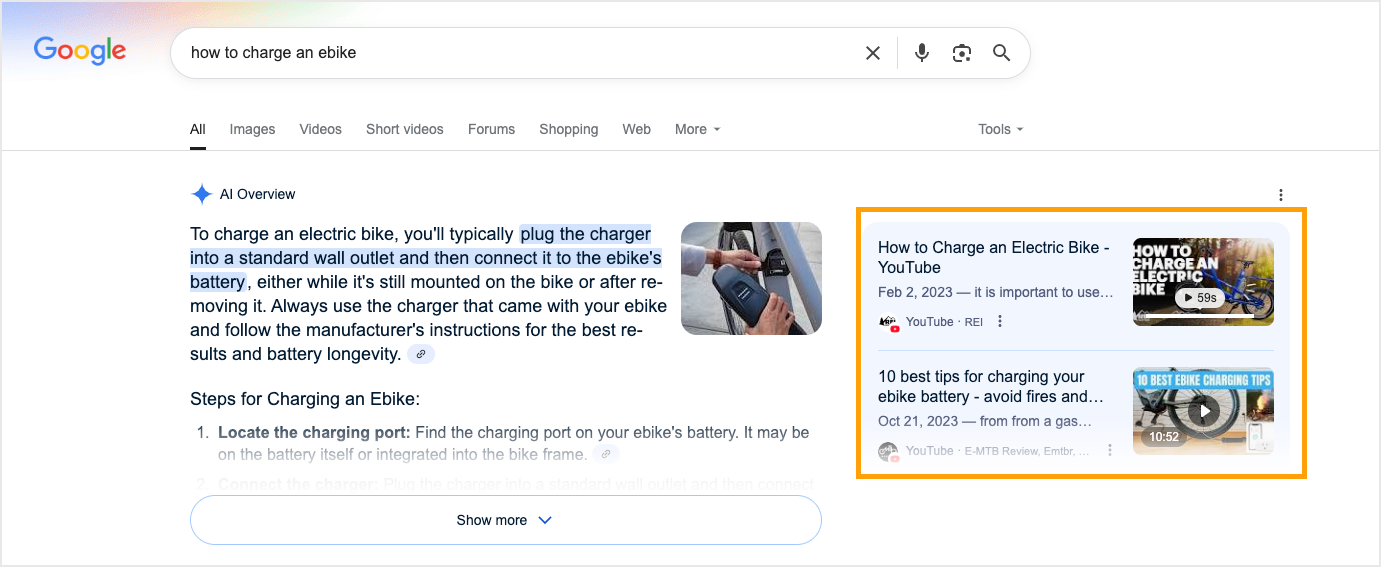
- For informational queries, consider adding step-by-step instructions or FAQs that clearly answer the target question
These are by no means all the ways in which you update or create content to target AI Overviews, but they are a great place to start.
Just remember! You likely won’t get traffic from these features, so be sure not to rely too heavily on conversion-focused content (save that for keywords that have a better chance of driving clicks!), and leverage this as an opportunity for brand visibility.
Non-AI Overview content strategy
When it comes to not targeting AIOs, there are a couple of different scenarios:
- You have content that is ranking and gets a lot of impressions, but no clicks due to the presence of an AIO.
- You’re working on creating new content and want to make sure you’re maximizing the opportunity to drive clicks and conversions.
In both these situations, whether you’re creating new content or updating an existing piece of content, it may make sense to target further down the funnel. Knowing that AIOs populate most often for informational, top-of-funnel queries, targeting keywords with a different search intent that are farther down the funnel could reduce the places where you find yourself competing with that SERP feature. This may include targeting more long-tail keywords, finding a new set of striking distance keywords, or simply pivoting to a different keyword cluster with varied search intent.
Target the right intent, every time with Moz

Pivot to a new search intent
Keyword Suggestions by Topic in Keyword Explorer makes it easy to pivot to a new search intent when updating and creating new content. To get started, head to Keyword Explorer and enter your original target keyword.
For this example, I’ll use the keyword “How to care for a cactus.” I know this is an informational query and that it features an AI Overview in the SERP. It is considered moderately difficult and features YouTube and Reddit in the cited sources for the AIO, so I don’t think I want to compete for a spot.
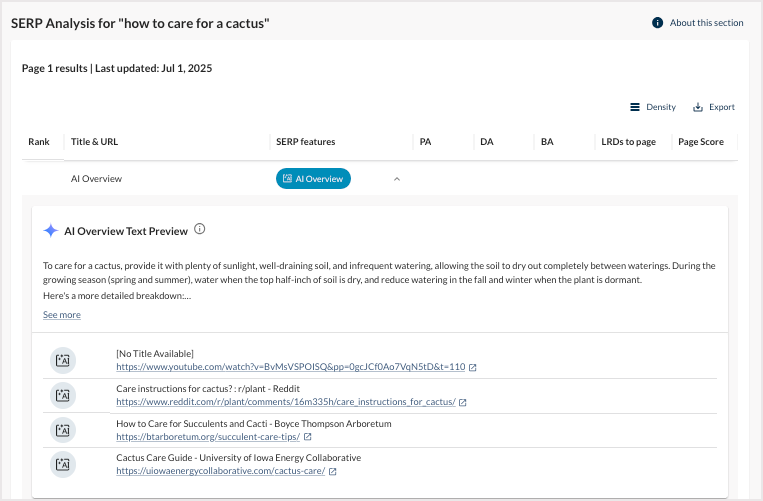
To identify a new keyword cluster with a different intent to target, I’m going to click on Top Suggestions (or use the left-hand navigation menu) to be taken to the Keyword Suggestions tool.
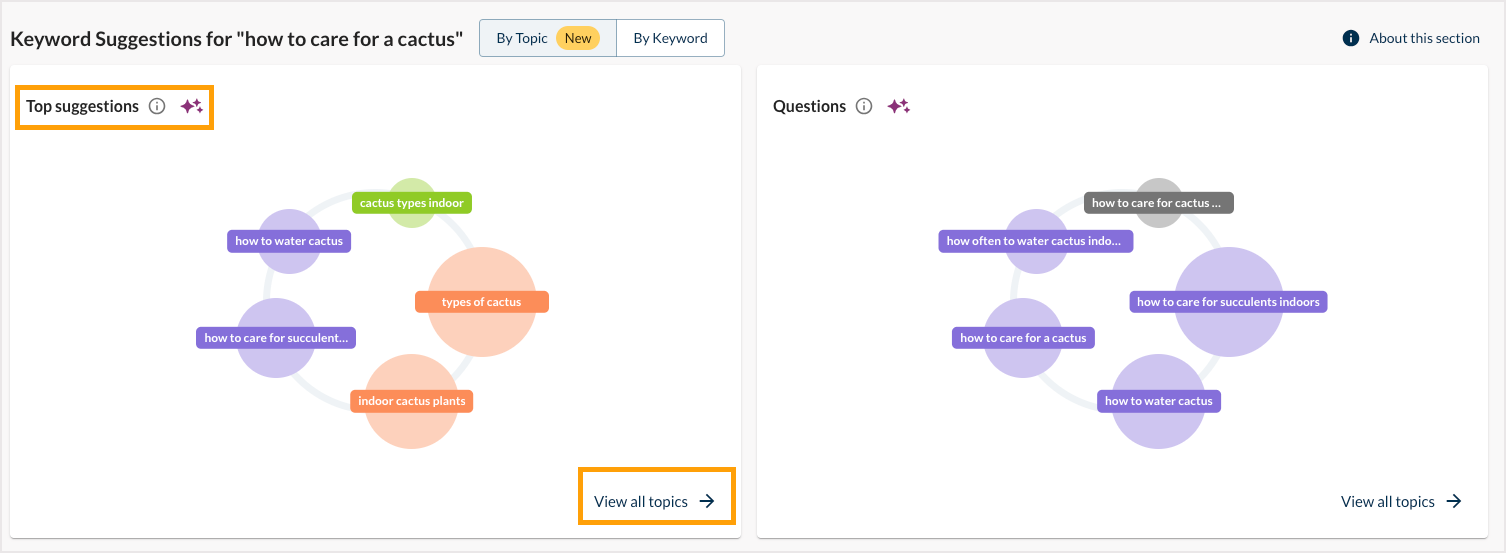
In the Keyword Suggestions tool, I can see that there are topic clusters related to my initial query that have commercial and transactional search intent. Targeting a keyword or group of keywords with these primary search intents will allow me to create content that is farther down the funnel and more directly related to conversions. It will also allow me to avoid having to compete with an AI Overview for impressions and clicks.
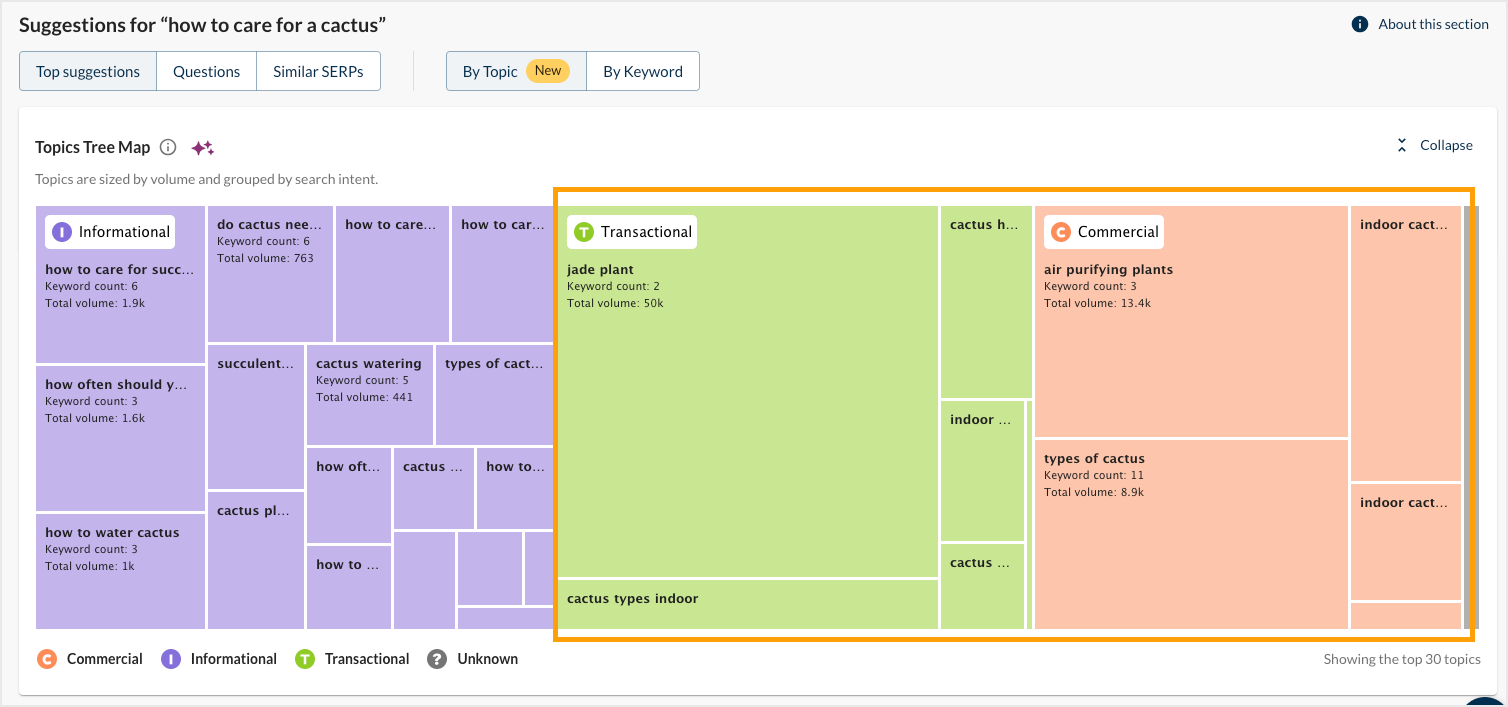
Pro tip! You can use the filter option above the Suggestions table to see only keyword topic groups that include search intents other than informational.

In this example, I am going to choose the “indoor cacti” keyword topic, which includes commercial and transactional keywords. I can then update or create new content to feature information about indoor cacti and still include my original content and target keyword of “how to care for a cactus,” as it is still topically relevant to indoor cacti.

I can even click on Analyze SERP to see what type of content is currently ranking for this keyword and who I would be competing against for the top spots. I can see here that an article about top cacti for indoors and how to care for them would likely do well and would target everything I’m looking to cover.

Wrapping up
So there you have it! As AI continues to be a part of our lives as marketers, we need to be able to adapt, adjust, and reconsider how we measure success. Now, you have everything you need to start investigating whether targeting AIOs is a good fit for your strategy or whether you should take a chance on a different tactic. You also have the tools to start digging into how to make those changes!



